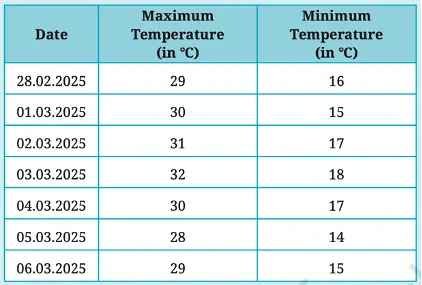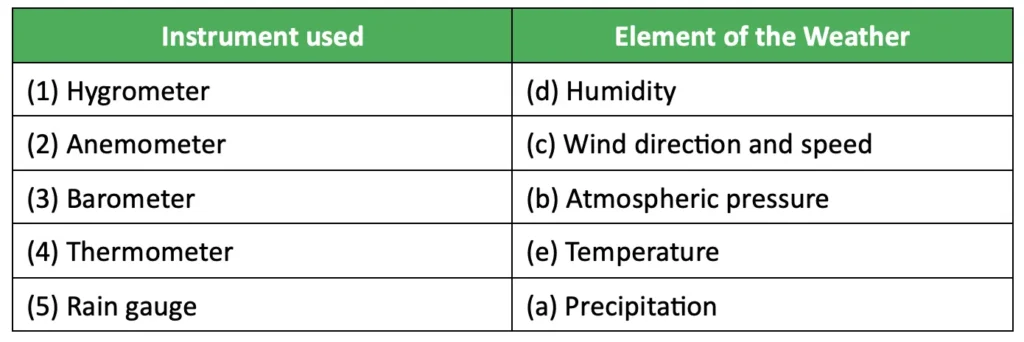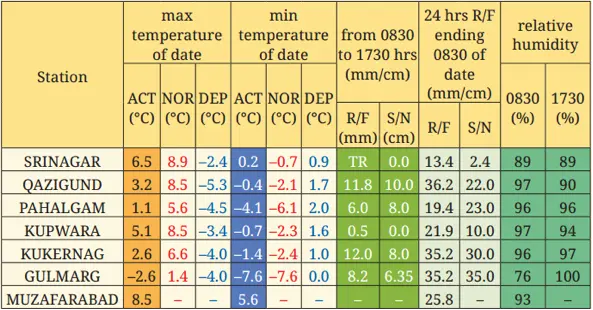Understanding The Weather Class 7 Questions And Answers Chapter 2 Social Science
This post discusses Class 7 Social Science Chapter 2 Understanding The Weather, Questions And Answers based on the Exploring Society: India and Beyond textbook for the 2025-26 session. Some important topics covered in the chapter are:
- Definition of weather and its elements, such as temperature, wind, humidity, atmospheric pressure, rainfall, and cloud cover.
- Forecasting weather by observing natural clues like cloud patterns, wind direction, animal behavior, etc.
- Temperature and its measurement.
- Measuring the amount of rainfall with a rain gauge.
- Atmospheric pressure, its significance and its measurement.
- Predicting the weather with the help of wind measuring instruments.
- Humidity, its measurement, and its importance in industrial processes.
Understanding The Weather Class 7 Questions And Answers – PDF Download
The Big Questions (Page 27)
1. How can we measure and monitor the weather around us?
Answer:
We can measure and monitor the weather around us using special tools called weather instruments. Some of them are:
(i) Thermometer – measures temperature.
(ii) Rain gauge – measures the amount of rainfall.
(iii) Barometer – measures atmospheric pressure.
(iv) Wind vane – shows the direction of the wind.
(v) Anemometer – measures wind speed.
(vi) Hygrometer – measures the humidity in the air.
2. How do weather predictions help us prepare for events like heavy rain, storms, drought and heat waves?
Answer:
Weather predictions play an important role in preparing for disasters.
(i) Heavy rain forecasts give us time to protect our homes, prepare emergency shelters, and stay indoors.
(ii) Storm forecasts help us board up windows, secure belongings, and move to safer locations.
(iii) Drought predictions can help adjust irrigation systems, conserve water, and plan for reduced agricultural yields.
(iv) Heat wave forecasts allow us to modify schedules to avoid peak heat hours and reduce the risk of heat-related illnesses.
Let’s Explore (Page 28)
Q. What are some of the words in your local language that you use to describe the weather? Hot, cold, warm, chilly, crisp, pleasant, and so on, are commonly used terms in English.
Answer:
Hindi is our local language, and in Hindi we use “bahut zyada garmi” for hot weather, “thand” for cold weather, “suhaavana mausam” for pleasant weather, “bahut zyada thand” for chilly weather, “baarish” or “barsaat” for rainy weather, and “garam mausam” for warm weather.
Let’s Explore (Page 29)
Q. What do you think could be some other reasons to measure the weather more precisely? (Hint: Think how knowing the weather a few hours or a few days in advance would help you plan some activities.)
Answer:
Some reasons to measure the weather more precisely are:
1️. It helps us plan and schedule our daily activities, such as deciding what to wear, whether to carry an umbrella, or whether to stay indoors to stay safe.
2️. It reduces agricultural losses by making farmers more aware of weather conditions for planting, irrigation, and harvesting.
3️. It enables governments to mobilize resources and prepare for potential disasters.
4️. Transportation facilities need accurate weather predictions to ensure safe travel and the smooth transportation of goods and people.
Let’s Explore (Page 30)
Q. Talk to elders in your neighbourhood and ask them how they predict the weather. What signs do they observe? Document any sayings in your regional language that refer to weather prediction.
Answer:
Do it yourself.
Don’t Miss Out (Page 32)
The India Meteorological Department was set up in 1875. Its motto is ādityāt jāyate vriṣhti, which means, “From the sun arises rain.” The phrase comes from the ancient text Manusmṛiti, and the complete sentence reads, “From the sun arises rain, from rain comes food, and from food, living beings originate.”
Q. Can you think of a reason why rain arises from the sun?
Answer:
Rain occurs because of the sun’s heat, which causes water to evaporate from rivers, lakes, and oceans. These water vapors rise into the sky, cool, and form clouds. When the clouds become heavy with water droplets, they release rain.
Let’s Explore (Page 32)
Q. Here’s a chart of the temperatures of a city in Madhya Pradesh. What is the maximum temperature recorded in the week shown here? What is the minimum? Calculate the range.

Answer:
The maximum temperature recorded in the week is 32°C and the minimum temperature is 14°C.
Temperature range = Maximum temp. – Minimum temp. = 32°C – 14°C = 18°C.
Q. Remember the conversation between Krishnan and Amir? If Krishnan said it was 20°C in Chennai and he was feeling a little cold, he and Amir would have a measure they could understand. What do you think Amir’s reaction to Krishnan’s statement might be?
Answer:
Amir might say, “Really! Is 20°C cold for you? Just imagine how you would feel if you experienced the -10°C temperature of Kashmir. For us, 20°C is quite pleasant!”
Let’s Explore (Page 34)
Q. Make a rain gauge as shown in the diagram above. Place the rain gauge in an open area, away from objects that might obstruct rain. Ensure that the rain gauge is on a flat surface and will not tilt or topple with the wind. Using the measuring scale, record the amount of rainwater collected at the same time every day, for a month. (If there is snow, allow it to melt before taking the measurement.) Calculate the average rainfall for every week in that month and comment on the variation from week to week.
Answer:
Do it yourself.
Think About It (Page 35)
Q. Why do you think it would be important to measure atmospheric pressure? Who are the people most likely to use such measurements?
Answer:
Atmospheric pressure is an essential factor in predicting weather. Low atmospheric pressure often signals poor weather conditions or storms, whereas high pressure typically indicates clear skies and calm weather.
Atmospheric pressure measurements are valuable for various professionals:
(i) Meteorologists use pressure data to forecast weather and issue timely warnings.
(ii) Aviation professionals and airlines rely on pressure readings to plan safe flight paths.
(iii) Mariners, including sailors and ship captains, depend on pressure data to avoid severe weather and storms at sea.
(iv) Mountaineers and hikers use pressure-measuring devices to monitor altitude changes and prevent altitude sickness.
(v) Scientists and researchers study atmospheric pressure to understand and interpret climate trends.
Think About It (Page 36)

Q. Have you seen seeds like these flying in the wind? What would happen to the seeds if there was no wind?
Answer:
Yes, I’ve seen such seeds flying in the wind. Without wind, the seeds would not be able to travel to far-off places to grow. This would reduce the number of plants growing in different areas, and over time, some plants and trees might disappear because their seeds could not spread properly.
Let’s Explore (Page 37)
Q. Where do you think humidity is likely to be more, Kochi or Jaipur? You might guess that Kochi has higher humidity than Jaipur because it is located near the sea. But how will we know for sure? If we had to compare the humidity level between Kochi and Mangaluru, how would we do it? Discuss with your classmates.
Answer:
By measuring the relative humidity of Kochi and Jaipur, we can confirm that Kochi has a higher humidity level than Jaipur. To compare the humidity levels between Kochi and Mangaluru, we need to check the relative humidity percentages of both cities at the same time of day, using weather reports or meteorological data.
Think About it (Page 38)
Q. If the humidity in Delhi is at 52% while in Kochi it is 84%, in which of the two places are wet clothes likely to dry faster? And where are you likely to sweat more, assuming the temperature is the same in both places?
Answer:
(i) Wet clothes are likely to dry faster in Delhi because lower humidity allows more moisture from the clothes to evaporate into the air.
(ii) We are likely to sweat more in Kochi, even if the temperature is the same, because higher humidity makes it harder for sweat to evaporate from your skin, making you feel hotter.
Let’s Explore (Page 41)
Q. Discuss, in pairs, different situations in which weather predictions are helpful. Make a list, and after you have completed it, share it and discuss it with the pair sitting next to you. How many different categories of situations have you been able to identify?
Answer:
List of different situations in which weather predictions are helpful:
(i) Deciding what to wear and whether to carry an umbrella or raincoat.
(ii) Helping fishermen plan sea routes and avoid going out to sea during harsh weather.
(iii) Scheduling outdoor events, such as marriages or festivals, while keeping the weather in mind.
(iv) Issuing early warnings for cyclones, droughts, or floods and carrying out evacuations if needed.
(v) Scheduling flights and road trips based on rain or snow predictions.
(vi) Helping farmers protect crops from hail, storms, or snow, and planning planting and harvesting based on rain forecasts.
I have been able to identify six categories of situations where weather predictions are helpful.
Let’s Explore (Page 41)

Q. What do you observe happening on that day? What are the various weather conditions that the IMD is alerting people to?
Answer:
We observed that the IMD issued alerts for various weather conditions on that day. The weather conditions that the IMD alerted people to include:
(i) Severe heatwave conditions in states such as Gujarat, Rajasthan, Uttar Pradesh, and Bihar.
(ii) Scattered thunderstorms and lightning, accompanied by heavy rain, in states such as Bihar, Assam, Meghalaya, and Karnataka.
Q. Which states have warning signs?
Answer:
States such as Punjab, Rajasthan, Haryana, Kerala and Tamil Nadu have warning signs for heat wave conditions or thunderstorms and lightning.
Q. Which parts of India are likely to be free from severe weather?
Answer:
Northeastern states, North-central India, and Eastern coastal states are likely to be free from severe weather.
Q. Which states are likely to face heat wave conditions?
Answer:
States such as Himachal Pradesh, Rajasthan, Punjab, Haryana, Delhi, Gujarat, Madhya Pradesh, Uttar Pradesh, and Bihar have been placed under red and orange alerts due to extreme heatwave conditions.
Q. What are the causes for warning in Tripura and Lakshadweep?
Answer:
Tripura: The warning is due to thunderstorms and lightning.
Lakshadweep: The warning is due to thunderstorms and lightning accompanied by heavy rain.
Questions and Activities (Page 42)
1. Match the instrument with the weather element it measures.

Answer:

2. Jyotsna is deciding what clothes to pack for her school trip to Mumbai in June. She looks at the weather forecast, which predicts 29°C and 84% humidity. What would be your advice to her?
Answer:
Here’s what I would advise Jyotsna to pack:
(i)Light, loose-fitting, breathable clothes made of cotton fabric, as they allow proper air circulation, absorb sweat, and help keep her cool.
(ii) A hat and sunglasses to provide protection from direct sun rays during outdoor activities.
(iii) Water-resistant sandals and comfortable footwear to protect her feet during rain and keep them cool.
(iv) A light rain jacket or umbrella to protect from the pre-monsoon showers that are common in the month of June in Mumbai.
3. Imagine that a small group of students is setting up a rain gauge. Here are some options for the site.
1. The school vegetable garden.
2. The terrace of the school building.
3. Open ground with elevated platform.
4. Compound wall of school.
5. Verandah of the school laboratory.
Discuss in your group and finalise the site. Write down the reasons for your decisions.
Answer:
The terrace of the school building or an open ground with an elevated platform would be the best sites for setting up a rain gauge. The reasons for choosing these locations are:
(i) They provide a flat surface, which helps keep the rain gauge stable and upright, even in windy conditions.
(ii) These sites are open and free from nearby trees, walls, or buildings that might block the rain.
4. Below is a chart taken from IMD, Jammu and Kashmir. Looking at the data available, write a short script to report the weather conditions in different parts of Jammu and Kashmir on the date shown. (Hint: Cover the temperature range, maximum and minimum temperatures, humidity, precipitation, etc.) Daily weather parameters Jammu & Kashmir (evening) date: 01-02-2024.

Answer:
Do it yourself.
